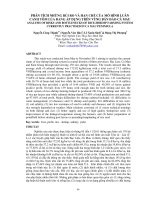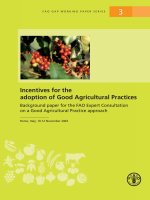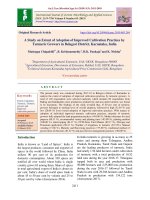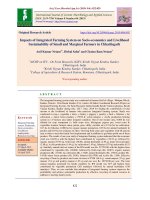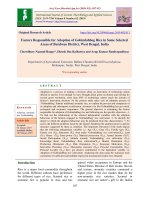Adoption of integrated rice-fish farming system by farmer of Ramchandrapuram
Bạn đang xem bản rút gọn của tài liệu. Xem và tải ngay bản đầy đủ của tài liệu tại đây (206.72 KB, 7 trang )
Int.J.Curr.Microbiol.App.Sci (2019) 8(1): 591-597
International Journal of Current Microbiology and Applied Sciences
ISSN: 2319-7706 Volume 8 Number 01 (2019)
Journal homepage:
Original Research Article
/>
Adoption of Integrated Rice-Fish Farming System by Farmer of
Ramchandrapuram
Bodi. Reena Rani1*, Sameer Daniel1, Maddi. Harshitha1 and Sri Pakalapati Rambabu2
1
College of Forestry, Sam Higginbottom University of Agriculture Technology and Sciences,
Naini, Allahabad (U.P.), India
2
ATMA (Ramchandrapuram), India
*Corresponding author
ABSTRACT
Keywords
Adoption,
Integrated
Rice-Fish farming
Farmer
Article Info
Accepted:
07 December 2018
Available Online:
10 January 2019
Paddy is important cereal crop of Andhra Pradesh state, particularly East and West
Godavari is considered as Rice bowl of Andhra Pradesh. It is cultivated under wide range
of soils and climatic conditions. It is grown in black soils as well as heavy clay loam soils.
In East Godavari district total rice production area is 4.23/ha. The major varieties grown in
Ramchandrapuram mandal are MTU-1010, PLU-1100. More than 70% of the Indian
farming community own less than one hectare of land. They belong to the category of
small and marginal farmers. Such farmers feel that, except going for a single cropping
system (like Paddy in canal irrigated lands, Groundnut in rainfed areas) there is hardly any
possibility of trying new practices or methods for farm improvement. To address the needs
of sustainable farming of such small and marginal farmers, an integrated farming model
has been developed with low cost. The model emphasize the significance of four important
sectors i.e., Agriculture, Fisheries, Horticulture and Animal Husbandry thus highlighting
the concept of integrating one with another in assuring better yields and results to farmers
who are eking their livelihood in these sectors. This model has been tried out in the field of
the beneficiary farmer Sri G. Venkateswara Babu Rao, resident of Kapavaram village &
mandal of Ramachandrapuram block, East Godavari District.
Introduction
Though the practice of rice-fish farming
differs from country, they all follow the same
principle of utilizing or recycling farm
resources for production. The major
differences in these farming systems are
mainly the variations in the field design,
species composition, stocking density, sizes,
crops, crop rotation etc., usually three types of
field designs which included the shallow
trench system within the rice field as seen in
Philippines, Indonesia and China; pond refuge
adjacent to rice field at one side and deep
water rice field system are practiced in India.
In these systems, different types of land
modifications are done for keeping and rearing
the fish. In Eastern Indian states, mainly pond
refuge and trench system of rice-fish farming
is following whereas broad bed-farrows
system is popular in the Andamans. The state
of Andhra Pradesh is known as “RICE BOWL
OF INDIA”, but now it’s CHATTISGARH
who have taken the place of Andhra Pradesh.
591
Int.J.Curr.Microbiol.App.Sci (2019) 8(1): 591-597
The only reason behind that is the less income
and high investments are obtaining from sole
rice crop in their fields, so many farmers in
these states especially the farmers who belong
to districts of East Godavari and West
Godavari which are predominantly called as
“RICE BOWL OF ANDHRA PRADESH”.
These districts have a high source of water
availability from river GODAVARI so the
farmers are leaving traditional agriculture and
converting their fields into fish ponds and
obtaining huge profits from it, but these is the
scenario of a decade before in those districts
right now these fish ponds are converting into
“INTEGRATED
RICE
AND
FISH
FARMING SYSTEMS”, which not only
became a profitable adaptation but also a
forward step for utilization of resources and
also a component of promoting “Blue-Green
revolution”.
Venkateswara Babu Rao who have started
IRFS in his field area of 1.7 acre from June,
2016 – April, 2017 under the supervision of
Pakalapati. Ramababu (Block Technology
Manager) of ATMA of Ramchandrapuram
mandal of East Godavari district of Andhra
Pradesh.
Farm details
Name of the farmer: Gundapaneni.
Sri Venkateswara Babu Rao
Field area: 1.7 acres; 1 acre for RICE,
0.5 acre for Fishes Trench.
Paddy varieties: RP Bio 226, RNR 15048.
Fish varieties: Grass Crap Ctenopharingodonidella
Catla - Catla catla
Rohu - Labeorohitha
Horticulture plants: Banana,
Coconut
Livestock: 2 Murrah Buffaloes
Materials and Methods
Papaya,
Locale of study
Operations undertaken in fishes trench
The present study was carried out in
Ramchandrapuram mandal in East Godavari
district of Andhra Pradesh state as this is one
of the major paddy growing areas of East
Godavari district. About 0.16 lakh hectare area
is under paddy crop in this district.
Selection of Mandal
There are 60 mandals in East Godavari
district. Out of 60 mandals in East Godavari
district, selection of Ramchandrapuram
mandal is selected as ATMA Block manager
of this mandal is promoting and guiding back
farmers to adapt this integration method as
income generation and sustainable farming.
While weeding in rice field and after
completion of that weeding process we will
apply 200kg/acre of GANIJAMRUTHAM.
In order to assure the level of bacterial
development in fishes trench we need to
increase level by applying Fermented Butter
Milk/Thati Kallu/Jeevamrutham @ 6 Lt/
Spray.
Vermicompost (100kg)
Pseudomonas (1lt) + Phosphobacteria (1lt) +
Azospiru
Feeds for fishes
Case study of farmer who have adopted
integrated rice-fish farming system
The calculation of “Integrated Rice-Fish
Farming System” of Sri Gundapaneni.
Litter of Hen: 25 Kg/ 3 Days
Rice Bran : 25 Kg/ 3 Days
Ginger Paste: 2Kg/ 2 Months
Raw Turmeric Paste: 2Kg/ 4-6 Months
592
Int.J.Curr.Microbiol.App.Sci (2019) 8(1): 591-597
Organic
supplements
for
jeevamrutham required items
field
Neemasthra required materials
Cow Dung
Cow Urine
Neem Leaves
Water
Cow Dung
- 5 Kgs
Cow Urine
- 5 Lts
Water - 20 Lts
Handful of Soil - Forest Soil/Bunds Soil
Gypsum/Lime - 50 gms
- 2 Kgs
- 10-15 Lts
- 10 Kgs
- 200 Lts
Method of preparation
Methods of preparation
Mix the cow urine and gypsum in 20lts of
water in which 5kg cow dung is tiedup in a
cloth bag was kept for 12hours to soak, stir the
contents in mean intervals.
Utilization
Sprinkle this composition on the seeds which
are ready for sowing as a part of seed
treatment allow them to dry under shady area,
such treated seeds will sprout in a healthy
manner and will prevent seed borne diseases.
Ghana Jeevamrutham required items
10 Kgs of Neem leaves are grounded as paste
and it was mixed in 200 lts of water. To that
mixture add 10-15lts of urine. Finally add
2Kgs of Cow Dung and mix it with stick. This
mixture was kept aside for 4-5 hrs by covering
it with lid. This mixture is well stored and
used at regular time intervals for better
maintanance of crop.
Results and Discussion
Case study of integrated rice-fish farming
system
adopted
by
farmer
of
Ramchandrapuram of East Godavari
District
This model has had its impact in two ways.
Cow Dung - 10 Kgs
Cow Urine - 2-5 Lts
Jaggery - 2 Kgs
Pulses Flour- 2 Kgs (except Soya and Ground
nut)
Forest Soil / Soil at Bunds- 2 Kgs
Firstly, better conservation and use of on-farm
natural resources thus establishing natural
ecosystem.
Method of preparation
Conservation and utilisation of on-farm
natural resources - maintaining ecological
equilibrium.
All the components are mixed well using cow
urine and that mixture was spread thoroughly
as thin layer in a shady area. The mixture is
allowed to dry for 7days and then dried layers
are finely powdered.
This fine powder can be stored for 6months in
a bag and can be used when required. This
finely grounded powder is sieved in field area
as this serve as a supplement for micro and
macro nutrients
Secondly, this model has been able to generate
money surplus every month in addition to
family consumption.
Soil moisture conservation
Bunding done across the slope, both on the
boundaries and around the paddy plot reduced
the speed of water flow, thus enabling
moisture retention. The vegetation on the
bunds helped in stabilising the bunds,
preventing soil erosion besides providing
fodder and green manure (Table 1).
593
Int.J.Curr.Microbiol.App.Sci (2019) 8(1): 591-597
Table.1 Case study of integrated rice-fish farming system adopted by farmer of
Ramchandrapuram of East Godavari district
SNo
Crop details
Paddy RP Paddy
BIO 226 RNR
(kharif)
15048
(Rabi)
Preparation of
2000
land/trench
Seed/sampling
250
2
Nurseries labour
5100
3
& transplantation
labour
weeding
3400
4
Manure/feed
1000
5
Pests
&
diseases
600
6
Cost of irrigation
7
Interest on
8
working capital
Rental value of
9
own land
Depreciation
10
Interest on fixed
11
capital
Land revenue
12
Insurance
13
Inputed value of
14
family labour
Harvest of crop
1200
15
/fish
Others
0
16
Yield
938
17
Unit cost(Rs)
22
18
Gross
19
20636
income(Rs)
Total
20
expenditure
Net profit
21
Cost A
22
COST B
23
COST C
24
560486
Gross Income
63268
Total Expenditure
70268
Net Profit
Cost Benefit Ratio 1:7
1
Banana Papaya
Coconut
1500
0
0
350
5000
660
500
1200
500
2900
800
600
0
350
0
0
100
50
Red
gram
0
0
Fish
(Grass
crap,
Catla,
Rohu)
2500
1080
1200
14
300
0
0
0
0
0
100
Dairy
0
6000
2100
0
0
0
5654
12600
0
0
500
0
0
0
6300
2250
1850
24200
4414
5500
594
5066
800
2500
1500
1200
0
0
0
200
3000
0
825
30
24750
0
540
35
18900
0
1840
10
18400
0
180
20
3600
0
20
130
2600
1000
3300
120
396000
0
5600
18000
26
60
75600
19000
560486
70268
63268
68768
70268
594
Int.J.Curr.Microbiol.App.Sci (2019) 8(1): 591-597
The farm pond is at the lowest point on the
field and the excess water which would have
otherwise gone waste gets collected in the
small pond. The harvested water is used for
irrigating horticulture crops.
The model depicts a fine blend of all the farm
enterprises where in each and every
component feeds into the other, thus making
efficient utilization of products, by-products
and also wastes generated on the farm. Multicropping systems always gives higher returns
than Mono crop as such it can be replicated in
other parts of the district and across the state
based on the feasibility of the water source.
Soil fertility
The crop residues on the bunds and the
animal wastes have been the major source for
composting manure. Thus the soil fertility
was managed by lowering chemical inputs
and more of organic farm litter.
References
Ali, A.B. (1992). Rice-fish farming in
Malaysia, Fertility and productivity. In
C.R. dela Cruz, C Lightfoot, B.A Costa
Pierce, V.R. Carangal and M.P Bimbao
(eds.)
Rice-fish
research
and
development in Asia, ICLARM Conf.
Proc:pp.24,457.
Costa Pierce, B. A., Dela cruz C.R.,
Lightfoot, C., Carangal, V. R. and M.P,
Bimbao. Eds. (1992). Rice-fish research
and development in Asia, International
centre for living Aquatic Resources
Management, Manila, Phillippines. pp.
261-281.
Dube, K. (1995). Integrated agriculture. A
systematic approach farming system,
Indian farming, 45(8): 12-15.
Fagi, A.M., Suriapermal, S. and Syamsiah, I.
(1994). Rice-fish farming research in
low land areas: the West Java case. In
Rice-fish research and development in
Asia. ICLARM Conf. Proc. 24, pp: 325331.
Fang, Xiuzhen., Guo, Xianzhen., Wang,
Jikun., Fang, Yingxue. and Liu, Zhiyun
(1994). A preliminary study on aerobic
heterotrophic bacteria in semi- intensive
polyculture fish pond. In: The selected
papers of basic integrated fish farming
theory and fishing bioeconomic
research, pp. 240-248.
Ghosh, A. and Saha, S.K. (1980). Scope of
Paddy cum fish culture in India, In
J.I.Furtado (ed.) Tropical ecology and
development part 2. (Proc. V. Internat.
Income generation
Livestock rearing started with two Murrah,
Jersey breed buffaloes The Murrah breed
buffalo produced 6 litres milk per day. These
will substitute the milk requirement by family
members.
Other farm enterprises
Pisciculture is one of the main activity that
yielded incomes by raising fish in the trench.
The farm pond served both as a nursery pond
for spawn to be stocked well as a watershed to
collect excess water and rain water.
Other benefits
Over a couple of months, besides the above
mentioned benefits, the farm family can
benefit from production of fruits from
horticulture plants. They can serve nutritional
needs and also provide some cash income.
These types of enterprises provide labour for
the family over the entire year.
Productivity, Profitability, Potentiality or
sustainability, Balanced food, Adoption of
new technology, Saving energy, Meeting
fodder crises, Solving fuel and timber,
Environmental safety, Recycling, Income
round the year, Employment generation,
Agro-industries, Increasing Input efficiency.
595
Int.J.Curr.Microbiol.App.Sci (2019) 8(1): 591-597
Symp. Trop ecol, 16-21 April 1979,
Kulalumpur, Malaysia). International
society
of
Tropical
Ecology,
Kualalumpur. pp. 1009-1015.
Ghosh, A., and P.K, Chakrabarti. (1990)
Rice-fish production system: A viable
technology
for
coastal
wetland
management in West Bengal. In, rice in
wetland ecosystem. Ed, R.R, Nair.,
K.P.V, Nair and C.A, Joseph,. Kerala
Agricultural University, pp. 261-267.
Ghosh, A. (1992). Rice fish farming
development in India: Past, Present and
Future. In C.R. ela Cruz, C. Lightfoot,
B.A. Costapierce, V.R. Carangal and
M.P. Bibao (eds) Rice fish research and
development in Asia. ICLARM Conf.
Proc. 24, 457. pp. 27-43.
Halwart, M. (1994). Fish as biocontrol agents
in rice. The potential of common carp
Cyprinus carpio (L) and Nile tilapia
Oreochromis niloticus (L) Trop
Agroecol. Weikersheim, Germany
Margraf Verlag. 8:169.
Hu Bautong Zhou Enhua. (1990). Selected
papers of Fresh water Fisheries
Research Jun, Fresh water Fisheries
Research Centre, Chinese Academy of
Fisheries Sciences, Asian - Pacific
Regional Research and Training Centre
for Integrated fish Farming. pp. 97-104.
Khoo, K. H. and E. S. D, Tan (1980). Review
of rice- fish culture in Southeast Asia,
ICLARM, Conf. Proc. 4, pp. 1-14.
Li- Kangmin. and Paw-Yinkhe. (1994). The
selected paper of basic integrated fish
farming
theory
and
fishery,
Bioeconomic research. Pp. 104-127
Lightfoot, C A., Roger., A.G, Caugaun. and
C.R, De La Cruz. (1990). A fish Crop
may improve rice yields and rice fields,
In Fish as a new crop in international
agricultural research. Nagar, ICLARM,
pp. 12-13.
Moody Keith. (1992). Fish crustacean- Weed
interactions. In Rice-Fish Research and
development in Asia., Ed.C. R, Dela
Cruz., C, Lightfoot., B.A, Costa Pierce.,
Muraleedharan, P.K. (1981). Resource
use efficiency in rice cultivation on low
lying lands in Kerala, Pillai K P (ed).
Agricultural development in Kerala,
Agricole Publishing Company. pp. 2128.
Nie, D. and J, Wang. (1981). Studies on rice
and fish mutualism. Fishery techniques
and information. 6: 1-3.
Nie, D., Y, Chen. and J, Wang. (1992).
Mutualism of Rice and Fish in rice
fields. In Rice-fish research and
development in Asia (Ed) C.R, Dela
Cruz., C, Lightfoot., B. A, CostaPierce.,
V.R,
Carangal
and
M.P.Bimbao. ICLARM Conf., Proc. 24,
pp. 173-175.
Padmakumar, K.G., Krishnan, A. and Nair, R.
R. (1993). Production maximization
through integrated farming approach for
low lands of Kerala. Paper presented at
the third India Fisheries Forum, Oct1114, 1993 Pan tanger. pp. 49-52.
Rajendran,
C.G.,
Abraham,
S.F.,
Mrithynjayan, P.S., Thampy, D.M. and
Jose, M.M(1981) Studies on fish culture
along with paddy Pokkali fields of
Kerala. All India Symposium on fresh
water biology. pp.17-18, 148-159.
Rajput,
U.V.
2004.Identification
of
indigenous agricultural practices and its
adoption by farmers M.Sc. Thesis
(unpub.) Dr. PKDV, Akola.
Sevilleja, R.C. and Lopez, E.A. (1986).
Rotational cropping patterns for rice
and fish. FAC progress report,
Freshwater aquaculture centre, Central
Luzon State University, Neuva Eeija,
Philippines. pp. 5-7.
Sevilleja, R.C. (1986). Alternate and
modified management system for rice
fish culture. In Report of 17th Asian
Rice Farming systems working Group,
Ministry of Agriculture and Food and
596
Int.J.Curr.Microbiol.App.Sci (2019) 8(1): 591-597
IRRI, Philippines. Pp. 28-36.
Thakre, I. S. 1980. Fertilizer utilization
behaviour of the farmers and constraints
in adoption. M. Sc. Thesis (Unpub.) Dr.
PDKV, Akola.
Vijayalayan, R. 2001. A study of awareness
knowledge and adoption of eco-friendly
agricultural practices in rice. M. Sc.
Thesis (Unpub.) Agricultural College
and Research Institute, Coimbatore. Pp.
88-90.
Wang, J. (1992). Methodology in extending
rice-fish farming system in China. In:
Rice-fish research and development in
Asia (Ed). C.R de La Cruz, C,
Lightfoot., B.A, Costa-Price., V.R,
Carangal and M.P, Bimbao. ICLARM
conf. proc. 24: 325-331.
How to cite this article:
Bodi. Reena Rani, Sameer Daniel, Maddi. Harshitha and Sri Pakalapati Rambabu. 2019.
Adoption of Integrated Rice-Fish Farming System by Farmer of Ramchandrapuram.
Int.J.Curr.Microbiol.App.Sci. 8(01): 591-597. doi: />
597
